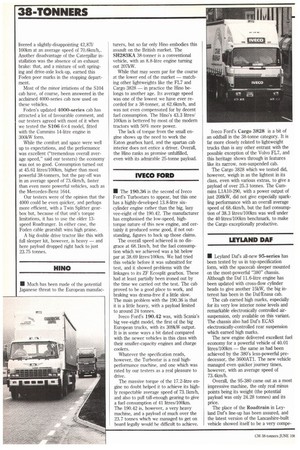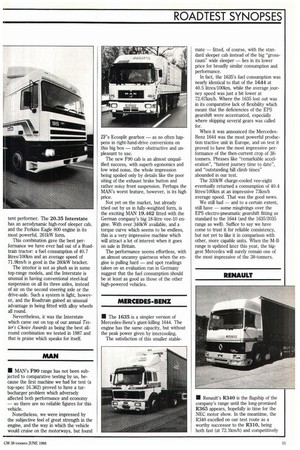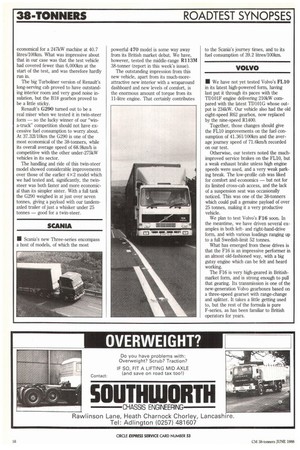LOOKING BACK AT THE HEAVYWEIGHTS
Page 121

Page 122

Page 123

Page 124

If you've noticed an error in this article please click here to report it so we can fix it.
In the course of a year we roadtest more 38-tonners than anyone else, and our tests are the most searching in the business. For this supplement we've been looking through our back issues to remind you what we thought of the top-weight contenders.
ERF
• ERF has enjoyed a bit of a reputation for being first with new proprietary components: it built on this by being the first to fit the air-to-air charge-cooled version of the 10-litre Cummins engine on the E10-325. The new 242kW engine certainly caused the record book to be rewritten, as this powerful machine gave better economy results even than the less-powerful Cummins 290-engined Iveco Ford Cargo 9828 while giving better journey times. The consumption figure of 37.7 litres/ 100Icm was a record for this power and weight, although the 70.781cm/h average speed for our Scottish test route has been bettered by several similarly-powered vehicles.
As usual, ERF's standard Eaton Twin Splitter gearbox helped the performance, as did the Jacobs engine brake. With a kerbweight of just 6.36 tonnes, the ERF offered an excellent payload of just over 25 tonnes as well, so it scored very high marks indeed. The ERF E14.32TT twin-steer follows the standard ERF formula of Cummins engine, Eaton gearbox and Rockwell axle. In this case it is the 14-litre Cummins in its 224kW (installed) form, connected to the Eaton Twin Splitter gearbox and the Rockwell CVC S 160E drive axle.
In standard sleeper form the E14 is of slightly lighter-than-average weight, and delivered a fuel consumption of 42.7 litres/ 100km, which is bettered by a few more powerful 38-tonners as well as quite a few of the lesser-powered vehicles in the class. Its average speed of 72.21crn/h is good without being outstanding, while comfort from the revamped SP4 steel/ composite cab with its Aeon rubber suspension is a great improvement on the older models.
When we tested it in October 1987, the ERF E14.35 fitted with Eaton's SAMT semi-automated transmission (the first vehicle to have SAMT as a regular production option) gave the best combination of performance and economy yet recorded by a 38-tonner over our Scottish test route. A fuel consumption of 40 litres/100Icm is considered as the break point for a 38-tonner: the ERF managed a superb 38.61/100km, while delivering a good 73.51cm/h average speed. There is no doubt in our minds that the slick-shifting SAMT — a firm favourite of this testing team — contributed to this performance, although overall the unit felt a little overgeared with a 3.73:1 drive-axle ratio which slowed it a little on motorways and fast A-roads. ERF's normally good brakes were helped on this vehicle by a Jacobs engine brake, which mated well with the SAMT to give strong engine braking.
FODEN
• Foden updated its cab just over a year ago, but left the mechanicals largely the same, so our 1986 test of the S104 model is still relevant. Foden is the only European manufacturer to fit Caterpillar engines: in this case, it was powered by the 3306H in air-to-air charge-cooled ATAAC form.
We have not had much success in squeezing good economy out of Caterpillar engines — and this was no exception. The theoretically-efficient ATAAC unit de livered a slightly-disappointing 42,871/ 100km at an average speed of 70.6km/h.,. Another disadvantage of the Caterpillar installation was the absence of an exhaust brake: that, and a mixture of soft springing and drive-axle lock-up, earned this Foden poor marks in the stopping department.
Most of the minor irriations of the S104 cab have, of course, been answered in the acclaimed 4000-series cab now used on these vehicles.
Foden's updated 4000-series cab has attracted a lot of favourable comment, and our testers agreed with most of it when we tested the S106 6x4 model, fitted with the Cummins 14-litre engine in 300kW form, While the comfort and space were well up to expectations, and the performance was excellent ("tremendous overall average speed," said our testers) the economy was not so good. Consumption turned out at 45.61 litres/100km, higher than most powerful 38-tonners, but the pay-off was in an average speed of 73.6km/h, faster than even more powerful vehicles, such as the Mercedes-Benz 1644.
Our testers were of the opinion that the 4000 could be even quicker, and perhaps more efficient, with a Twin Splitter gearbox but, because of that unit's torque limitations, it has to use the older 13speed Roadranger. In either case, the Foden cable gearshift wins high praise.
A big double drive tractor like this with full sleeper kit, however, is heavy — and here payload dropped right back to just 23.75 tonnes.
NINO
• Much has been made of the potential Japanese threat to the European manufac turers, but so far only Hino embodies this assault on the British market. The SH283KA 38-tonner is a conventional vehicle, with an 8.8-litre engine turning out 207kW.
While that may seem par for the course at the lower end of the market — matching other lightweights like the FL7 and Cargo 3828 — in practice the Hino belongs to another age. Its average speed was one of the lowest we have ever recorded for a 38-V:inner, at 62.6km/h, and was not even compensated for by decent fuel consumption. The Hino's 43.3 litres/ 100Iun is bettered by most of the modern tractors with 50% more power.
The lack of torque from the small engine shows up the need to work the Eaton gearbox hard, and the spartan cab interior does not entice a driver. Overall, the Hino ranks as promise unfulfilled, even with its admirable 25-tonne payload.
IVECO FORD
• The 190.36 is the second of Iveco Ford's Turbostars to appear, but this one has a highly-developed 13.8-litre sixcylinder engine rather than the big, lazy vee-eight of the 190.42. The manufacturer has emphasised the low-speed, hightorque nature of this new engine, and certainly it produced some good, if not outstanding, figures to back up those claims.
The overall speed achieved is no disgrace at 68.11cm/h, but the fuel consumption which we achieved was a bit below par at 38.69 litres/100km. We had tried this vehicle before it was submitted for test, and it showed problems with the linkages to its ZF Ecosplit gearbox. These had at least partially been ironed out by the time we carried out the test. The cab proved to be a good place to work, and braking was drama-free if a little slow. The main problem with the 190.36 is that it is a little heavy, with a payload limited to around 24 tonnes.
Iveco Ford's 190.42 was, with Scania's big vee-eight model, the first of the big European trucks, with its 309kW output. It is in some ways a bit dated compared with the newer vehicles in this class with their smaller-capacity engines and charge coolers,
Whatever the specification reads, however, the Turhostar is a real highperformance machine, and one which was rated by our testers as a real pleasure to drive.
The massive torque of the 17.2-litre engine no doubt helped it to achieve its highly respectable average speed of 73.1km/h, and also to pull tall-enough gearing to give a fuel consumption of 41 litres/100Icm. The 190.42 is, however, a very heavy machine, and a payload of much over the 23.7 tonnes which we managed to get on board legally would he difficult to achieve. Iveco Ford's Cargo 3828 is a bit of an oddball in the 38-tonne category. It is far more closely related to lightweight trucks than is any other entrant with the possible exception of the Volvo FL7, and this heritage shows through in features like its narrow, non-suspended cab.
The Cargo 3828 which we tested did, however, weigh in as the lightest in its class, even with various extras, to ,give a payload of over 25.3 tonnes. The Cummins L1A10-290, with a power output of just 208kW, did not give especially sparkling performance with an overall average speed of 68.4km/h, but the fuel consumption of 38.3 litres/100Icm was well under the 40 litres/100km benchmark, to make the Cargo exceptionally productive.
LEYLAND DAF
• Leyland Des all-new 95-series has been tested by us in top-specification form, with the spacec,ab sleeper mounted on the most-powerful "380" chassis. Although the Daf 11.6-litre engine has been updated with cross-flow cylinder heads to give another 15kW, the big interest has been in the Daf/Enasa cab.
The cab earned high marks, especially for its very low interior noise levels and remarkable electronically controlled airsuspension, only available on this variant. The chassis also had Daf's ECAS electronically-controlled rear suspension which earned high marks.
The new engine delivered excellent fuel economy for a powerful vehicle of 40.01 litres/1001un — the same as had been achieved by the 380's less-powerful predecessor, the 3600AT1. The new vehicle managed even quicker journey times, however, with an average speed of 73.4km/h.
Overall, the 95-380 came out as a most impressive machine, the only real minus points being its weight (the potential payload was only 24.28 tonnes) and its price.
The place of the Roadtrain in Leyland Daf's line-up has been assured, and the latest version of the Lancashire-built vehicle showed itself to be a very compe tent performer. The 20.35 Interstate has an aerodynamic high-roof sleeper cab, and the Perkins Eagle 800 engine in its most powerful, 261kW form.
This combination gave the best performance we have ever had out of a Roadtrain tractor: a fuel consumption of 40.7 litres/100km and an average speed of 71.91[1-nth is good in the 260kW bracket.
The interior is not as plush as in some top-range models, and the Interstate is unusual in having conventional steel-leaf suspension on all its three axles, instead of air on the second steering axle or the drive-axle. Such a system is light, however, and the Roadtrain gained an unusual advantage in being fitted with alloy wheels all round.
Nevertheless, it was the Interstate which came out on top of our annual Tester's Choke Awards as being the best allround combination we tested in 1987 and that is praise which speaks for itself.
MAN
• MAN's F90 range has not been subjected to comparative testing by us, because the first machine we had for test (a top-spec 16.362) proved to have a turbocharger problem which adversely affected both performance and economy — so there are no reliable figures for this vehicle.
Nonetheless, we were impressed by the subjective feel of great strength in the engine, and the way in which the vehicle would cruise on the motorways, but found ZF's Ecospfit gearbox — as so often happens in right-hand-drive conversions on this big box — rather obstructive and unpleasant to use.
The new F90 cab is an almost unqualified success, with superb egonomics and low wind noise, the whole impression being spoiled only by details like the poor siting of the exhaust brake button and rather noisy front suspension. Perhaps the MAN's worst feature, however, is its high price.
Not yet on the market, but already tried out by us in fully-weighted form, is the exciting MAN 19.462 fitted with the German company's big 18-litre vee-10 engine. With over 340kW available, and a torque curve which seems to be endless, this is a very impressive machine which will attract a lot of interest when it goes on sale in Britain.
The performance seems effortless, with an almost uncanny quietness when the engine is pulling hard — and spot readings taken on an evaluation run in Germany suggest that the fuel consumption should be at least as good as those of the other high-powered vehicles.
MERCEDES-BENZ
• The 1635 is a simpler version of Mercedes-Benz's giant-killing 1644. The engine has the same capacity, but without the peak power given by intercooling.
The satisfaction of this smaller stable mate — fitted, of course, with the standard sleeper cab instead of the big "grossraum" wide sleeper — lies in its lower price for broadly similar consumption and performance.
In fact, the 1635's fuel consumption was nearly identical to that of the 1644 at 40.5 litres/100km, while the average journey speed was just a bit lower at 72.67km/h. Where the 1635 lost out was in its comparative lack of flexibility which meant that the deficiencies of the EPS gearshift were accentuated, especially where skipping several gears was called for.
When it was announced the MercedesBenz 1644 was the most powerful production tractive unit in Europe, and on test it proved to have the most impressive performance of the then-current crop of 38tonners. Phrases like "remarkable acceleration", "fastest journey time to date", and "outstanding hill climb times" abounded in our test.
The 320kW charge-cooled vee-eight eventually returned a consumption of 40.4 litres/100km at an impressive 73km/h average speed. That was the good news.
We still had — and to a certain extent, still have — some misgivings over the EPS electro-pneumatic gearshift fitting as standard to the 164.4 (and the 1635/2035 range as well). Suffice to say we have come to trust it for reliable consistency, but not yet to like it in comparison with other, more capable units. When the M-B range is updated later this year, the biggest Mercedes will surely remain one of the most impressive of the 38-tonners.
RENAULT
• Renault's R340 is the flagship of the company's range until the long-promised R365 appears, hopefully in time for the NEC motor show. In the meantime, the R340 excelled on our test route as a worthy successor to the R310, being both fast (at 72.1Icm/h) and competitively economical for a 247kW machine at 40.7 litres/100km. What was impressive about that in our case was that the test vehicle had covered fewer than 6,000km at the start of the test, and was therefore hardly run in.
The big Turboliner version of Renault's long-serving cab proved to have outstanding interior room and very good noise insulation, but the B18 gearbox proved to be a little sticky.
Renault's G290 turned out to be a real miser when we tested it in twin-steer form — so the lucky winner of our "wina-truck" competition should not have excessive fuel consumption to worry about. At 37.321/10km the G290 is one of the most economical of the 38-tonners, while its overall average speed of 68.91Ernib is competitive with the other under-275kW vehicles in its sector.
The handling and ride of this twin-steer model showed considerable improvements over those of the earlier 4x2 model which we had tested and, significantly, the twinsteer was both faster and more economical than its simpler sister. With a full tank the G290 weighed in at just over seven tonnes, giving a payload with our tandemaxled trailer of just a whisker under 25 tonnes — good for a twin-steer.
SCANIA
• Scania's new Three-series encompass a host of models, of which the most powerful 470 model is some way away from its British market debut. We have, however, tested the middle-range Rl13M 38-tonner (report in this week's issue).
The outstanding impression from this new vehicle, apart from its much-moreattractive new interior with a wraparound dashboard and new levels of comfort, is the enormous amount of torque from its 11-litre engine. That certainly contributes to the Scania's journey times, and to its fuel consumption of 39.2 litres/100km.
VOLVO
• We have not yet tested Volvo's FL10 in its latest high-powered form, having last put it through its paces with the TD101F engine delivering 210kW compared with the latest TD101G whose output is 234kW. Our vehicle also had the old eight-speed R62 gearbox, now replaced by the nine-speed R1400.
Together, those changes should give the FL10 improvements on the fuel consumption of 41.361/100km and the average journey speed of 71.6krn/h recorded on our test.
Otherwise, our testers noted the muchimproved service brakes on the FLIO, but a weak exhaust brake unless high engine speeds were used, and a very weak parking break. The low-profile cab was liked for comfort and economics — but not for its limited cross-cab access, and the lack of a suspension seat was occasionally noticed. This was one of the 38-tonners which could pull a genuine payload of over 25 tonnes, making it a very productive vehicle.
We plan to test Volvo's F16 soon. In the meantime, we have driven several examples in both leftand right-hand-drive form, and with various loadings ranging up to a full Swedish-limit 52 tonnes.
What has emerged from these drives is that the F16 is an impressive performer in an almost old-fashioned way, with a big gutsy engine which can be felt and heard working.
The F16 is very high-geared in Britishmarket form, and is strong enough to pull that gearing. Its transmission is one of the new-generation Volvo gearboxes based on a three-speed gearset with range-change and splitter. It takes a little getting used to, but the rest of the formula is pure F-series, as has been familiar to British operators for years.
























































































































































